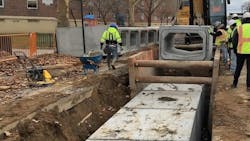In addition, the wetland in the Fresh Creek Basin Nature Preserve was restored. The saltmarsh cordgrass habitat was graded and expanded in accordance with a design that was developed with the NYC Department of Parks and Recreation. Fill, debris, invasive species and other ecological impairments were removed to create nearly 30,000 square feet of restored wetlands in two wetland zones comprised of 21,200 square feet of intertidal marsh and 8,000 square feet of high marsh.
Plantings to compliment the saltmarsh cordgrass include saltmeadow cordgrass, spikegrass, and black grass rush. Nearly 34,000 square feet of coastal forest was created to enhance the overall ecology of the preserve.
Altogether, the three phases cover an approximately 419-acre drainage area and reduce combined sewer overflows into Fresh Creek, a tributary of Jamaica Bay. The increased collection of stormwater runoff reduces roadway and property flooding and separates out an estimated 50 percent of the stormwater flow from the combined sewers.
By reducing pressure on the existing combined sewer system, modeling shows that overflows into Fresh Creek will be reduced by approximately 189 million gallons annually. This project is part of an agreement between New York City and the New York State Department of Environmental Conservation that aims to significantly improve the health of New York Harbor.





